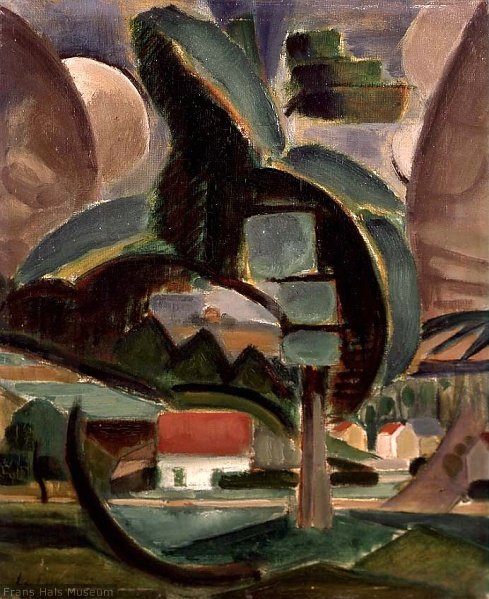Description
Henri Le Fauconnier's "El Tree", created in 1912, is registered in the context of the Cubist movement, which revolutionized the pictorial representation in the change of the century. Le Fauconnier, as a significant member of Cubism, channels in this painting the desire to capture not only the form, but also the essence of his subject. When observing "the tree", we face a composition that, in its apparent simplicity, encloses a deep structural complexity.
The work stands out for its bold use of color and its geometric fragmentation. The tree, the undisputed protagonist of the painting, develops in a series of plans that overlap and intertwine, giving it a sensation of three -dimensionality. Its trunk, robust and almost sculptoric, decomposes into facets that suggest a richer reality than mere naturalistic representation. The palette used is predominantly in shades of green, brown and dark blue, which evoke a wild atmosphere and at the same time gloomy, creating a visual contrast between the parts of the tree and the surrounding space.
There are no visible characters, but the absence of human figures does not subtract life from work. On the contrary, "the tree" seems like a lonely witness of nature, inviting the viewer to reflect on their own existence in a world where geometry and nature coexist in the same plane. This representation of the tree can be interpreted as a symbol of permanence and resistance to life changes, a theme that resonates with the tumultuous era in which the work was created, marked by socio -political tensions and a rapid technological advance.
Le Fauconnier, within the cubist movement, establishes a bridge between the formal analysis of the object and the emotional expression of nature. His style resembles that of other Cubist exponents such as Georges Braque and Pablo Picasso, although his particular approach to living nature gives him a distinctive nuance. The way in which natural elements breaks down and tries to integrate them into an alternative visual language points towards a search for truth beyond superficial representation.
In the broadest context of the art of the early twentieth century, "the tree" is erected as a powerful example of artists' desire to challenge established conventions and explore new forms of perception. Le Fauconnier takes the viewer to a new interpretation of the landscape, a place where nature becomes a series of interactive surfaces that challenge to be observed from different angles and perspectives. This visual interaction invites the viewer to participate in an intimate dialogue with the work, promoting a reflection that goes beyond the literal.
In short, "the tree" is more than a mere representation of a natural object; It is a testimony of the art capacity to reinterpret reality and propose new visions of the world. Through formal innovation and exploration of texture and color, Henri Le Fauconnier offers the viewer an aesthetic experience that remains relevant in the contemporary context. The work reminds us that, despite the changes, the essence of nature endures, and that art has the power to capture that eternity in its visual framework.
KUADROS ©, a famous paint on your wall.
Hand-made oil painting reproductions, with the quality of professional artists and the distinctive seal of KUADROS ©.
Art reproduction service with satisfaction guarantee. If you are not completely satisfied with the replica of your painting, we refund your money 100%.

